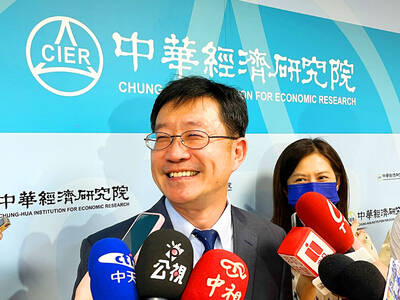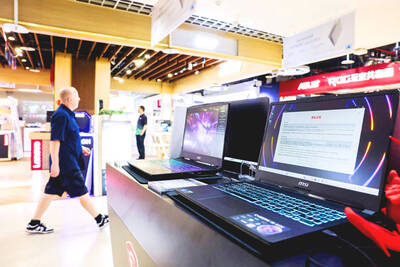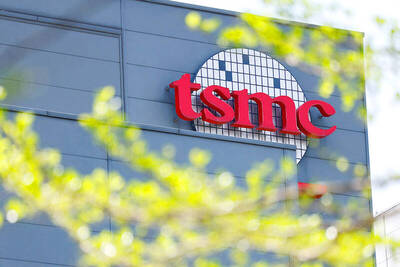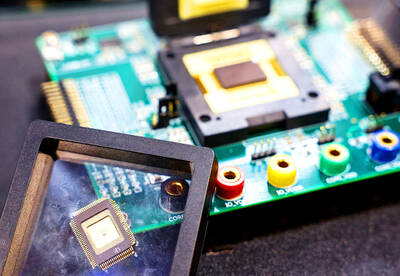World markets fell yesterday after the US Federal Reserve unexpectedly raised interest rates for emergency bank loans, triggering fears that regular borrowing costs could also move higher soon, slowing the recovery in the world’s largest economy.
The central bank said on Thursday it would bump up the “discount” lending rate by one-quarter point to 0.75 percent effective yesterday, part of a pullback of the extraordinary aid it provided to fight the financial crisis.
Although the Fed said the step should not be seen as a signal that it would soon boost interest rates for consumers and businesses, markets were spooked.
After sharp drops in Asia, Germany’s DAX stock index was down 0.2 percent at 5,671.28 and Britain’s FTSE 100 was flat at 5,326.84. France’s CAC-40 fell 0.2 percent to 3,742.09.
Wall Street was also expected to fall on the open. Dow Jones industrials futures were down 50 points at 10,325.00 and Standard Poor’s 500 futures were 8.2 points lower at 1,097.40.
Growing optimism about the strength of the US economy had helped boost the Dow Jones industrial average rise by 3 percent over the past three days. But the surprise Fed announcement after Wall Street trading closed left traders wondering whether the so-called “exit strategy” from a loose monetary policy could come faster than expected and stifle US consumer demand.
“It begs the questions of why this was not done, or at least signaled at a regular Federal Open Market Committee meeting,” said Marc Ostwald, strategist at Monument Securities in London.
“It certainly is the case that the Fed wants to see how money markets function without so much of the liquidity life support that the Fed has been providing, and as such one can term this a form of ‘kite flying,’” Ostwald said.
The Fed move also helped boost the US dollar and push the euro below nine-month lows — a sign traders may be turning away from higher-risk investments, analysts said.
The euro fell to US$1.3504 from US$1.3529 late on Thursday after trading at nine-month lows below US$1.3400. After rising against the Japanese yen, the dollar was flat at ¥91.75.
Economic data in Europe, meanwhile, failed to shore up investor sentiment. The purchasing managers’ survey of the eurozone, an economic indicator published by Markit research group, was stable this month, suggesting the recovery from recession has stagnated somewhat.
In Asia, Hong Kong’s Hang Seng stock index led decliners, diving 528.13, or 2.6 percent, to 19,894.02 while Japan’s Nikkei 225 stock average dropped 212.11, or 2.1 percent, to 10,123.58.
“As the dollar strengthens, we see less appetite for riskier assets such as Asian stocks,” said Jit Soon Lim, head of equity research for Southeast Asia for Nomura in Singapore. “We’re bullish on the region’s economic growth, but bearish on risk.”
South Korea’s Kospi declined 27.29, or 1.7 percent, to 1,593.90.
Singapore’s stock measure retreated 0.9 percent despite an increase of the government’s economic growth forecast for this year.
Markets in China and Taiwan were closed this week for the Lunar New Year holiday.
In the US on Thursday, the Dow rose 83.66, or 0.8 percent, to 10,392.90 while the Standard & Poor’s 500 index rose 7.24, or 0.7 percent, to 1,106.75. The NASDAQ rose 15.42, or 0.7 percent, to 2,241.71.

WEAKER ACTIVITY: The sharpest deterioration was seen in the electronics and optical components sector, with the production index falling 13.2 points to 44.5 Taiwan’s manufacturing sector last month contracted for a second consecutive month, with the purchasing managers’ index (PMI) slipping to 48, reflecting ongoing caution over trade uncertainties, the Chung-Hua Institution for Economic Research (CIER, 中華經濟研究院) said yesterday. The decline reflects growing caution among companies amid uncertainty surrounding US tariffs, semiconductor duties and automotive import levies, and it is also likely linked to fading front-loading activity, CIER president Lien Hsien-ming (連賢明) said. “Some clients have started shifting orders to Southeast Asian countries where tariff regimes are already clear,” Lien told a news conference. Firms across the supply chain are also lowering stock levels to mitigate

IN THE AIR: While most companies said they were committed to North American operations, some added that production and costs would depend on the outcome of a US trade probe Leading local contract electronics makers Wistron Corp (緯創), Quanta Computer Inc (廣達), Inventec Corp (英業達) and Compal Electronics Inc (仁寶) are to maintain their North American expansion plans, despite Washington’s 20 percent tariff on Taiwanese goods. Wistron said it has long maintained a presence in the US, while distributing production across Taiwan, North America, Southeast Asia and Europe. The company is in talks with customers to align capacity with their site preferences, a company official told the Taipei Times by telephone on Friday. The company is still in talks with clients over who would bear the tariff costs, with the outcome pending further

Six Taiwanese companies, including contract chipmaker Taiwan Semiconductor Manufacturing Co (TSMC, 台積電), made the 2025 Fortune Global 500 list of the world’s largest firms by revenue. In a report published by New York-based Fortune magazine on Tuesday, Hon Hai Precision Industry Co (鴻海精密), also known as Foxconn Technology Group (富士康科技集團), ranked highest among Taiwanese firms, placing 28th with revenue of US$213.69 billion. Up 60 spots from last year, TSMC rose to No. 126 with US$90.16 billion in revenue, followed by Quanta Computer Inc (廣達) at 348th, Pegatron Corp (和碩) at 461st, CPC Corp, Taiwan (台灣中油) at 494th and Wistron Corp (緯創) at

NEGOTIATIONS: Semiconductors play an outsized role in Taiwan’s industrial and economic development and are a major driver of the Taiwan-US trade imbalance With US President Donald Trump threatening to impose tariffs on semiconductors, Taiwan is expected to face a significant challenge, as information and communications technology (ICT) products account for more than 70 percent of its exports to the US, Chung-Hua Institution for Economic Research (CIER, 中華經濟研究院) president Lien Hsien-ming (連賢明) said on Friday. Compared with other countries, semiconductors play a disproportionately large role in Taiwan’s industrial and economic development, Lien said. As the sixth-largest contributor to the US trade deficit, Taiwan recorded a US$73.9 billion trade surplus with the US last year — up from US$47.8 billion in 2023 — driven by strong